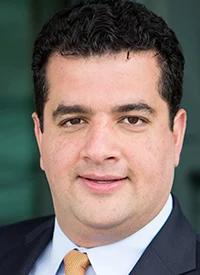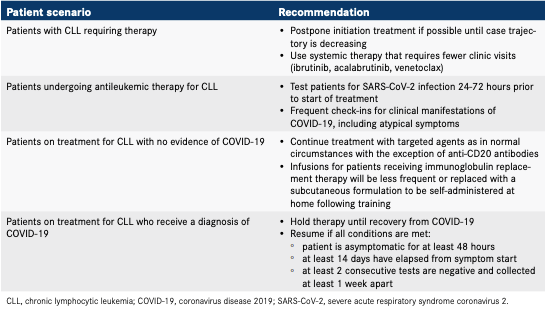Article
COVID-19 Pandemic Restructures Care in CLL
Author(s):
As the coronavirus disease 2019 pandemic continues to pose challenges, health care providers struggle with decisions on how to balance the risk of severe acute respiratory syndrome coronavirus 2 transmission with the need to treat patients’ underlying conditions.
John N. Allan, MD

As the coronavirus disease (COVID-19) pandemic continues to pose challenges, health care providers struggle with decisions on how to balance the risk of severe acute respiratory syndrome coronavirus 2 (SARS-CoV-2) transmission with the need to treat patients’ underlying conditions. Because patients with chronic lymphocytic leukemia (CLL) have many risk factors that predispose them to a more severe course of COVID-19– related illness, including older age, higher prevalence of comorbidities, immunodeficiency from leukemia, and, possibly, immunosuppression from CLL treatments, this patient population is of particular concern.1 As part of a segment during an OncLive Peer Exchange®, a panel of hematologic cancer experts discussed how they are caring for their patients with CLL during the pandemic. They also discussed how treatment advances, many of which have the potential to transform the CLL landscape, may set standards should other pandemics emerge, a concern that has become particularly important as infectious disease experts warn that we may have entered an “era of pandemics.”2
“We know there are emerging data that show that patients receiving chemotherapy and patients with cancer on therapy in general are at a higher risk for poor outcomes [related to COVID-19],” said John N. Allan, MD, an assistant professor of medicine in the Division of Hematology and Medical Oncology at Weill Cornell Medicine in New York, New York.
Although the mortality data for patients with CLL who develop COVID-19 are alarming, Allan provided some reassurance. “I want to reiterate to patients and other physicians out there that just because a patient with CLL may get sick does not mean he or she is going to have horrible outcomes, though they are at risk for those things,” he said. He noted that many factors beyond CLL come into play and must be considered. “I think what we’ve shown time and time again with patients with COVID-19 is that age, hypertension, kidney disease, diabetes, obesity, and pulmonary disease are the things that really come together in a perfect storm. Patients are dying from overwhelming inflammatory conditions that occur with the virus that we are trying to grapple with and understand,” he said.
Protective measures must be taken and relayed to patients to help reduce the risk of SARS-CoV-2 transmission. “One way to mitigate risk is to encourage social distancing, use of masks, and hand hygiene, and really reiterate that,” Allen said. Using telemedicine when possible is also an option to minimize office visits. “There are a proportion of our patients who are on active observation, for example, who certainly can use telemedicine,” Nicole Lamanna, MD, said. “Patients can have local laboratory tests; there are services that some patients use that can have labs drawn at home, depending upon their insurance or capabilities, or they can go to a local lab and then have a telemedicine visit because they’ve been stable for years and they’re doing well otherwise.” Lamanna is an associate clinical professor of medicine at Columbia University Herbert Irving Comprehensive Cancer Center in New York, New York.
Nicole Lamanna, MD

Additionally, outside influences, such as regional status concerning the number of cases as well as the potential therapeutic benefit of initiating treatments, are other case-by-case considerations. In the absence of symptoms, delaying intervention for patients who receive a diagnosis of CLL is common.3 “For patients with CLL I have found when we are in an exponential phase [of the pandemic], it is not a time when you want to be initiating treatment,” Allan said. “Instead, you want to minimize interaction and the immunosuppressive effects of some of these treatments and, essentially, if you do have a watch-and-wait patient, that’s when you push them out to telemedicine and using local labs.”
In a guideline article for treating patients with CLL during the SARS-CoV-2 pandemic, Rossi et al estimate that the risk of contracting SARS-CoV-2 and developing COVID-19 outweighs the risk associated with delaying treatment until a time when the epidemic trajectory descreases.4
In contrast, if someone is sick and meets the standard treatment indications, Lamanna said the patient should be brought in to ensure they receive adequate treatment and avoid complications down the road. Mazyar Shadman, MD, MPH, agreed, saying, “Unfortunately, we have had a few patients who were not referred in a timely manner or decided to wait until the end of the pandemic. As a result, we had a more complicated situation in terms of starting treatment.” Shadman is an assistant professor at the University of Washington School of Medicine and an associate professor at Fred Hutchinson Cancer Research Center both in Seattle, Washington.
Mazyar Shadman, MD, MPH

When treatment cannot be further delayed, guidelines recommend using systemic therapies that are less immunosuppressive and require fewer in-person visits (Table).4 During such times, the panelists agreed that Bruton tyrosine kinase inhibitors (BTKis) may be a particularly appealing option for patients requiring treatment because they are well tolerated, require minimal monitoring, and are taken orally. Options include ibrutinib (Imbruvica) and acalabrutinib (Calquence), which prolong progression-free and overall survival and have a lower risk of infection for patients compared with chemoimmunotherapy. Of note, ibrutinib does not allow for treatment holidays. For patients who are not candidates for BTKis, venetoclax (Venclexta) has a similar incidence of adverse effects, including rates for opportunistic infections; however, patients treated with the agent may require access to a hospital for the treatment of tumor lysis syndrome during the initial stages of therapy.4
Table. Recommendations for Patients With CLL Who Require Treatment During the COVID-19 Pandemic4

Allan, Lamanna, and Shadman coauthored a study across 43 international centers that examined the outcomes of 198 patients with CLL who developed symptomatic COVID-19. The median age of the patients was 70.5 years. Of these patients, 90% required hospitalization. At a median follow-up of 16 days, the overall case fatality rate was 33%, and 25% remained admitted.1 The rates of hospital admission were similar between the treatment-naïve and treated patients, most of whom were treated with BTKis (76%). Although mortality rates for all patients with CLL was high following hospital admission for COVID-19, CLL-directed treatment with BTKis did not negatively impact survival, with a case fatality rate of 34% versus 35% for those not on BTKis.1
In most of these patients, BTKi therapy was held at the time they received a diagnosis of COVID-19; however, a small subset of patients (n = 14) continued to receive BTKis and they had a lower case fatality rate (21%). These patients also appeared to require less frequent supplemental oxygen and mechanical ventilation, providing reassurance that continued BTKi use during the COVID-19 pandemic is unlikely to cause harm and may have benefit. However, data from larger studies will be needed for confirmation.1
In contrast, when COVID-19 cases are low, Allan said he may be more comfortable going back to more intensive approaches. “If I thought a patient would benefit from a VenG [venetoclax plus obinutuzumab (Gazyva)]-based approach pre–COVID-19, I’m comfortable doing this [when cases are low]. I feel like there’s a window of opportunity, though that could change if we start to see a [new] wave. You just have to pay attention to your caseload and what the virus rates are specific to your region,” Allan said.
Although the CLL COVID-19 study provided reassurance that BTKis do not negatively impact mortality, it is still unclear what effects other treatments alone or in combination have overall, especially more intensive regimens. Allan shared his experience in the clinic and noted that he has seen people on anti-CD20 treatment do well after developing COVID-19. “I’ve had patients get sick who have had anti-CD20. They have recovered, though it took a little time to clear, but then they finally developed antibodies while being on a BTK inhibitor plus an anti-CD20 [therapy],” he said.
Lessons learned from the pandemic are likely to remain at the forefront, especially if SARS-CoV-2 transitions from an epidemic state to an endemic state with recurrent seasonal outbreaks. As such, Rossi et al caution that patients and doctors be prepared for surges and outbreaks to adapt care for those with CLL when stay-at-home orders are in place.4 Although recent data on the continued use of BTKis is encouraging, more data will modify approaches to care in the coming months and years.
References
- Mato AR, Roeker LE, Lamanna N, et al. Outcomes of COVID-19 in patients with CLL: a multicenter international experience. Blood. 2020;136(10):1134-1143. doi:10.1182/blood.2020006965
- Morens DM, Fauci AS. Emerging pandemic diseases: how we got to COVID-19. Cell. 2020;183(3):837. doi:10.1016/j.cell.2020.10.022
- NCCN. Clinical Practice Guidelines in Oncology. Chronic lymphocytic leukemia/small lymphocytic leukemia, version 1.2021. Accessed November 18, 2020. https://www.nccn.org/professionals/physician_gls/pdf/cll.pdf
- Rossi D, Shadman M, Condoluci A, et al. How we manage patients with chronic lymphocytic leukemia during the SARS-CoV-2 pandemic. Hemasphere. 2020;4(4):e432. doi:10.1097/HS9.0000000000000432






%20(2)%201-Recovered-Recovered-Recovered-Recovered-Recovered.jpg?fit=crop&auto=format)

%20(2)%201-Recovered-Recovered-Recovered-Recovered-Recovered.jpg?fit=crop&auto=format)
%20(2)%201-Recovered-Recovered-Recovered-Recovered-Recovered.jpg?fit=crop&auto=format)